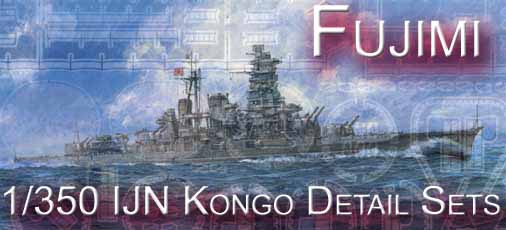|
The past year has been great for 1/350 IJN modellers, as the Japanese manufacturers continue to release new ships. Fujimi has been the third company to release a 1/350 subject, after Hasegawa and Aoshima.
A similarly new trend is for the manufacturers to release dedicated PE sets for their products under their own name. It has to be said that the initial releases were clearly inferior to those of the established aftermarket producers.
This article will explore Fujimi’s dedicated PE releases for the Kongo. Things seem to be changing on the manufacturer PE front!
When the ship was first released in April 2008, two PE sets were released at the same time. They were labelled “basic” sets, and are similar in quality to previously released dedicated sets by other manufacturers. In other words, they are useful but more crude than the products by companies such as GMM and WEM.
The first basic set deals with the ship’s railings, amusingly described by the auto-translator in Japanese hobby shops as “balustrades”. They are typical of Japanese-produced railings in that they do not have the “bottom rail” commonly used to glue the rail to the plastic, but have individual “shoes” that you bend and glue individually. The set is presented in rather thick and inflexible nickel/silver coloured metal. It’s not bad, but not as good as, for example, the GMM Takao railing.
The second basic fret is also nickel/silver. It contains catapults, aircraft dollies, bridge windows, radars, searchlight platforms, funnel caps, aircraft propellers, the “towers” on the main turrets and a few small details. The quality, once again, is OK, but nothing to write home about.
The situation changes with the “deluxe PE set”, which was released in the beginning of June 2008. This set consists of three very thin brass frets (A, B, and B2), which are similar in look and feel to WEM and GMM products. The presentation is better than the competitors though; each fret is in a separate sealed bag, sandwiched between thick white paper and transparent plastic. Additionally, they include the ship’s name in individual Japanese characters, 1 cm tall, in gold self-adhesive plastic.
I compared the thickness of the brass sheet to a GMM sheet. It is actually a small fraction thinner than the GMM Takao sheet that I used for comparison. What does it contain? A lot of stuff!
|


